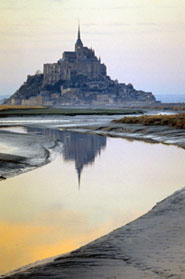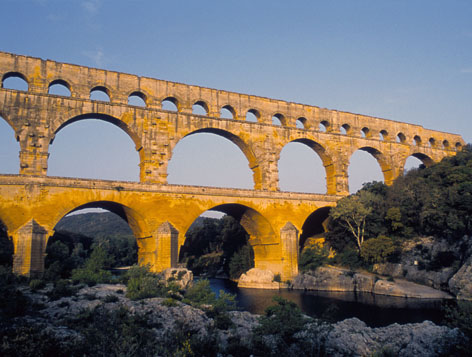WORLD HERITAGE SITES
in France
There are more than 30 World Heritage Sites in France, and just visiting these alone will account for many repeat visits to the country.
The brief extracts below are drawn from the UNESCO website, which should be consulted for full information about all World Heritage Sites in France.
The Episcopal City of Albi presents a complete built ensemble representative of a type of urban development in Europe from the Middle Ages to the present day.
Alps: Prehistoric Pile dwellings
The series of 111 out of the 937 known archaeological pile-dwelling sites in six countries around the Alpine and sub-alpine regions of Europe is composed of the remains of prehistoric settlements dating from 5,000 to 500 BCE, which are situated under water, on lake shores, along rivers or in wetlands.
In the heart of Picardy, the cathedral in Amiens is one of the largest, classic 13th-century Gothic churches, notable for the coherence of its plan, the beauty of its interior elevation, and the fine display of sculptures on the principal facade and in the south transept.
Arles: Roman and Romanesque monuments
Arles is a significant example of the appropriation of a classical city by a medieval European civilisation. The town owes its prosperity to the decline of its rival, Marseille. It has retained impressive Roman monuments of which the earliest, the Arena, the Roman Theatre, and the Cryptoporticus (subterranean galleries) date back more than 2,000 years.
Avignon: Historic Centre, Papal Palace, Episcopal Ensemble and Avignon Bridge
In the 14th century, Avignon was the seat of the papacy. The Palais des Papes, an austere-looking fortress dominates the centre of the city, the surrounding ramparts and the remains of a 12th-century bridge over the Rhone.
|
Belfries of France and Belgium Twenty-three belfries in the north of France and the belfry of Gembloux in Belgium were inscribed as a group, an extension to the 32 Belgian belfries inscribed in 1999 as Belfries of Flanders and Wallonia. Built between the 11th and 17th centuries, they showcase the Roman, Gothic, Renaissance and Baroque styles of architecture. Alain Corbin's book Village Bells gives an excellent account of the significance of bells in French communities. |
|
The Port of the Moon, port city of Bordeaux, is an outstanding example of the exchange of human values over more than 2,000 years, due to its role as capital city of a world-famous wine production region, and the importance of its port in commerce at regional and international levels. The urban form and architecture of the city are the result of continuous extensions and renovations since Roman times up to the 20th century.
Bourges Cathedral was award World Heritage Site status because of its importance in the development of Gothic architecture, and as a symbol of Christianity in medieval France. But its principal claim lies in its striking beauty, combining masterly management of space with harmonious proportions and decoration of the highest quality.
|
This 360-km network of navigable waterways linking the Medi-terranean and the Atlantic through 328 structures (locks, aqueducts, bridges, tunnels, etc.) is one of the most remarkable feats of civil engineering in modern times. It provided the model for the flowering of technology that led directly to the Industrial Revolution and the modern technological age. It represents a significant period in European history, that of the development of water transport as a result of mastery of hydraulic civil engineering. The story of the building of the canal is described in great detail in Chandra Mukerji's book Impossible Engineering. |
|
Carcassonne: Historic Fortified City
The historic city of Carcassonne is a superb example of a medieval fortified town whose massive defences were constructed on walls dating from late antiquity. It is of exceptional significance by virtue of the restoration work carried out in the second half of the 19th century by Viollet-le-Duc, which had a profound influence on subsequent developments in conservation principles and practice.
The Causses and the Cévennes: Mediterranean agro-pastoral Cultural Landscape
The upland landscapes of the Causses have been shaped by agro-pastoralism over three millennia. In the Middle Ages, the development of cities in the surrounding Mediterranean plains, and especially the growth of religious institutions, prompted the evolution of a land structure based on agro-pastoralism, the basis of which is still in place today. Too poor to host cities, too rich to be abandoned, the landscape of Causses and Cévennes are the result of the modification of the natural environment by agro-pastoral systems over a millennium.
Partly built starting in 1145, and then reconstructed over a 26-year period after a fire in 1194, Chartres Cathedral marks the high point of French Gothic art. The vast nave, the porches adorned with fine sculptures from the middle of the 12th century, and the magnificent 12th- and 13th-century stained-glass windows, all in remarkable condition, combine to make it a masterpiece.
Fontainebleau: Palace and Park
Used by the kings of France from the 12th century, the medieval royal hunting lodge of Fontainebleau, standing at the heart of a vast forest in the Île-de-France, was transformed, enlarged and embellished in the 16th century by François I. From then on it was one of the most important and prestigious sites of the French Court.
This Burgundian monastery was founded by St Bernard in 1119. With its church, cloister, refectory, sleeping quarters, bakery and ironworks, it is an excellent illustration of the ideal of self-sufficiency as practised by the earliest communities of Cistercian monks.
Le Havre: the City Rebuilt by Auguste Perret
Le Havre, on the English Channel in Normandy, was severely bombed during the Second World War. The destroyed area was rebuilt according to the plan of a team headed by Auguste Perret, from 1945 to 1964. Le Havre is exceptional among many reconstructed cities for its unity and integrity, combining a reflection of the earlier pattern of the town and its extant historic structures with the new ideas of town planning and construction technology.
Loire valley between Sully-sur-Loire and Chalonnes
The Loire valley is an outstanding cultural landscape that bears witness to an interchange of human values and to a harmonious development of interactions between human beings and their environment over two millennia. It is noteworthy for the quality of its architectural heritage, in its historic towns such as Blois, Chinon, Orléans, Saumur and Tours, but in particular in its world-famous castles, such as the Château de Chambord.
Lyon bears testimony to the continuity of urban settlement over more than 2,000 years on a site of great commercial and strategic significance, where cultural traditions from many parts of Europe came together to create a coherent and vigorous community. Because of the way in which it has developed spatially, Lyon illustrates the progress and evolution of architectural design and town planning over many centuries.
 |
Perched on a rocky islet in the midst of vast sandbanks exposed to powerful tides between Normandy and Brittany stands a Gothic-style Benedictine abbey, and the village that grew up beneath its great walls. Built between the 11th and 16th centuries, the abbey is a technical and artistic tour de force, having had to adapt to the problems posed by this unique natural site. |
Nancy: Place Stanislas, Place de la Carrière and Place d'Alliance
At the end of the 17th century the French, who had occupied Nancy, established a means of communication with the New Town by opening a gate in the walls, calling it the Royal Gate in honour of Louis XIV. Stanislas Leszczynski, unhappy pretender to the Polish throne and father-in-law of Louis XV, King of France, received as a recompense for his abdication the Dukedom of Lorraine for life. He 'reigned' there peacefully from 1737 to 1766. It was during the reign of Stanislas that the link between the Old Town and the New Town took a concrete form.
Orange: Roman Theatre and its surroundings and the Triumphal Arch
The ancient theatre of Orange, with its 103m-long facade, is one of the best preserved of all the great Roman theatres. Built between AD10 and 25, the Roman arch is one of the most beautiful and interesting surviving examples of a provincial triumphal arch from the reign of Augustus.
The banks of the Seine are studded with masterpieces, including Notre Dame, the Louvre, the Palais de l'lnstitut, Les Invalides, Place de la Concorde, École Militaire, La Monnaie (Mint), Grand Palais des Champs Elysées, Eiffel Tower and Palais de Chaillot. A number of them, such as Notre Dame and the Sainte Chapelle, were definitive references in the spread of Gothic construction, while the Place de la Concorde or the vista at the Invalides exerted influence on the urban development of European capitals.

Pont du Gard © ATOUT FRANCE/Jean François Tripelon-Jarry
The Pont du Gard was constructed in about 50AD to allow the Nîmes aqueduct (which is almost 50km long) to cross the Gard river.. It was laid out in three levels and has been a World Heritage site since 1985, and is a technical as well as an artistic masterpiece.
Production of Open-pan Salt: From the Great Saltworks of Salins-les-Bains to the Royal Saltworks of Arc-et-Senans
The saltworks in Salins-les-Bains and Arc-et-Senans demonstrate outstanding universal value in terms of the extent of the chronological timeframe during which the extraction of salt continued in Salins, certainly from the Middle Ages, and probably from prehistoric times, through to the 20th century. Spa activity has extended its use until nowadays.
Provins: Town of Medieval Fairs
A thousand years ago, Provins was one of several towns in the territory of the Counts of Champagne that became the venues for great annual trading fairs linking northern Europe with the Mediterranean world. It preserves to a high degree the architecture and urban layout that characterize these great medieval fair towns.
Reims: Cathedral of Notre-Dame, Former Abbey of Saint-Rémi and Palace of Tau
Notre-Dame in Reims is a masterpieces of Gothic art. The former abbey still has its beautiful 9th-century nave, in which lie the remains of Archbishop St Rémi (440-533), who instituted the Holy Anointing of the kings of France. The former archiepiscopal palace known as the Tau Palace, which played an important role in religious ceremonies, was almost entirely rebuilt in the 17th century.
Routes of Santiago de Compostela in France
The Pilgrimage Route of Santiago de Compostela played a key role in religious and cultural exchange and development during the later Middle Ages, and this is admirably illustrated by the carefully selected monuments on the routes followed by pilgrims in France. The four main pilgrimage routes to Santiago de Compostela in France began at Paris, Vézelay, Le Puy, and Arles respectively, and each of these was fed by a number of subsidiary routes.
Saint-Emilion: Jurisdiction of
Viticulture was introduced to Aquitaine by the Romans, and intensified in the Middle Ages. The Saint-Emilion area benefited from its location on the pilgrimage route to Santiago de Compostela and many churches, monasteries and hospices were built there from the 11th century onwards. It was granted the special status of a 'jurisdiction' during the period of English rule in the 12th century. It is an exceptional landscape devoted entirely to wine-growing, with many fine historic monuments in its towns and villages.
Saint-Savin sur Gartempe: Abbey Church
Known as the 'Romanesque Sistine Chapel', the Abbey-Church of Saint-Savin contains many beautiful 11th- and 12th-century murals which are still in a remarkable state of preservation.

The Grande Île of Strasbourg (above) is an outstanding example of an urban ensemble characteristic of central Europe and a unique ensemble of domestic architecture in the Rhine Valley of the 15th and 16th centuries. It represents the eastward vector of the Gothic art movement. Surrounded by two arms of the River Ill, the Grande Ile is the historic centre of the Alsatian capital. It has an outstanding complex of monuments within a fairly small area.
The work of Vauban constitutes a major contribution to universal military architecture. It crystallises earlier strategic theories into a rational system of fortifications based on a concrete relationship to territory. It bears witness to the evolution of European fortification in the 17th century and produced models used all over the world up to the mid-19th century, thereby illustrating a significant period of history.
The Palace of Versailles was the principal residence of the French kings from the time of Louis XIV to Louis XVI. Embellished by several generations of architects, sculptors, decorators and landscape architects, it provided Europe with a model of the ideal royal residence for over a century.
Shortly after its foundation in the 9th century, the Benedictine abbey of Vézelay acquired the relics of St Mary Magdalene and since then it has been an important place of pilgrimage.
Vézère valley: prehistoric sites and decorated caves
The objects and works of art found in the Vézère valley bear extremely rare witness to long-extinct civilisations which are very difficult to understand. The valley contains 147 prehistoric sites dating from the Palaeolithic, and 25 decorated caves. This material is of universal interest as being exceptional from historic as well as ethnological, anthropological and aesthetic points of view.
This website was built using Site Build It!








